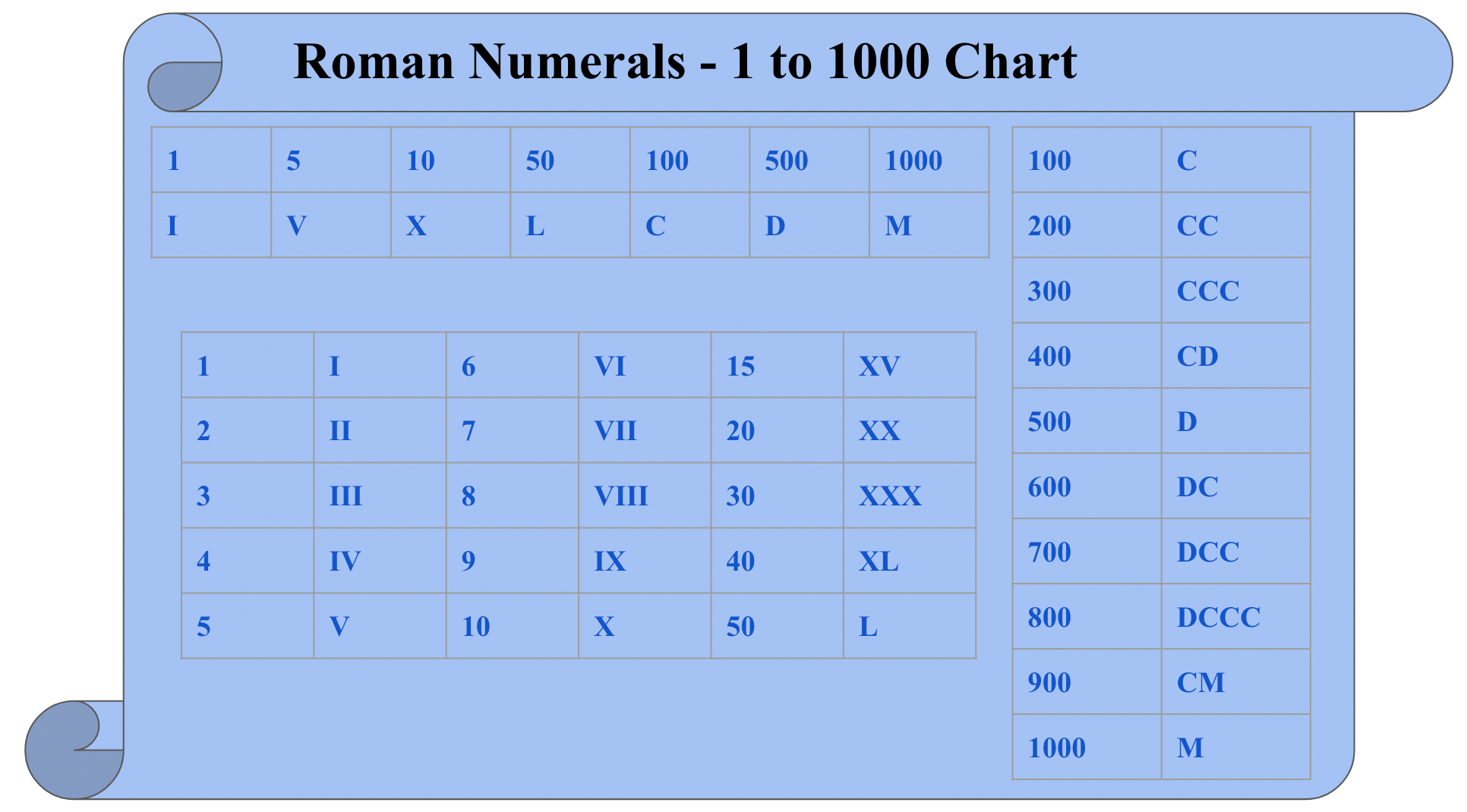Roman numerals are a numeral system that originated in ancient Rome and was used throughout the Roman Empire. They are based on a combination of letters from the Latin alphabet to represent numbers. In basic math classes, it is one of the important topics for kids to learn and write Roman numerals. It is also important to identify the Roman numerals that are appeared in multiple places including textbooks, question papers, brochures, etc.
What are Roman Numerals?
Roman numerals are an ancient number system used and are used in many places. In Roman numerals or the alphabet are used to represent fixed positive numbers. For instance, Roman numerals I, II, III, IV, and V represent 1, 2, 3, 4, and 5, respectively.
The standard representation of Roman numerals
Here is a basic guide to Roman numerals and their corresponding values:
I: 1
V: 5
X: 10
L: 50
C: 100
D: 500
M: 1000

Rules for Writing Roman Numerals
Roman numerals are written by combining these basic symbols. The larger value symbols are placed to the left of the smaller value symbols, and the values are added together to get the total value. However, there are certain rules to follow:
- If a smaller value symbol appears to the left of a larger value symbol, the smaller value is subtracted from the larger value. For example, IV represents 4 (5 – 1) and IX represents 9 (10 – 1).
- The subtractive principle applies only to I, X, and C. For example, 99 is represented as XCIX (XC = 90, IX = 9).
- A symbol is not repeated more than three times in a row. If a value needs to be represented that is greater than the limit of three repetitions, a horizontal line is placed above the symbol to indicate multiplication by 1,000. For example, 4,000 is represented as IV̅ (IV with a line above it).
Here are some examples of numbers written in Roman numerals:
50: L
100: C
500: D
1000: M
List of Roman Numerals from 1 to 100
The below table contains the Roman numeral representation for the numbers from 1 to 100.
| 1 = I | 26 = XXVI | 51 = LI | 76 = LXXVI |
| 2 = II | 27 = XXVII | 52 = LII | 77 = LXXVII |
| 3 = III | 28 = XXVIII | 53 = LIII | 78 = LXXVIII |
| 4 = IV | 29 = XXIX | 54 = LIV | 79 = LXXIX |
| 5 = V | 30 = XXX | 55 = LV | 80 = LXXX |
| 6 = VI | 31 = XXXI | 56 = LVI | 81 = LXXXI |
| 7 = VII | 32 = XXXII | 57 = LVII | 82 = LXXXII |
| 8 = VIII | 33 = XXXIII | 58 = LVIII | 83 = LXXXIII |
| 9 = IX | 34 = XXXIV | 59 = LIX | 84 = LXXXIV |
| 10 = X | 35 = XXXV | 60 = LX | 85 = LXXXV |
| 11 = XI | 36 = XXXVI | 61 = LXI | 86 = LXXXVI |
| 12 = XII | 37 = XXXVII | 62 = LXII | 87 = LXXXVII |
| 13 = XIII | 38 = XXXVIII | 63 = LXIII | 88 = LXXXVIII |
| 14 = XIV | 39 = XXXIX | 64 = LXIV | 89 = LXXXIX |
| 15 = XV | 40 = XL | 65 = LXV | 90 = XC |
| 16 = XVI | 41 = XLI | 66 = LXVI | 91 = XCI |
| 17 = XVII | 42 = XLII | 67 = LXVII | 92 = XCII |
| 18 = XVIII | 43 = XLIII | 68 = LXVIII | 93 = XCIII |
| 19 = XIX | 44 = XLIV | 69 = LXIX | 94 = XCIV |
| 20 = XX | 45 = XLV | 70 = LXX | 95 = XCV |
| 21 = XXI | 46 = XLVI | 71 = LXXI | 96 = XCVI |
| 22 = XXII | 47 = XLVII | 72 = LXXII | 97 = XCVII |
| 23 = XXIII | 48 = XLVIII | 73 = LXXIII | 98 = XCVIII |
| 24 = XXIV | 49 = XLIX | 74 = LXXIV | 99 = XCIX |
| 25 = XXV | 50 = L | 75 = LXXV | 100 = C |
It’s worth noting that Roman numerals are still used today in certain contexts, such as indicating the year on some clocks or numbering the pages of prefaces and introductions in books.
Solved Examples on Roman Numerals
Example 1: Write 2021 in Roman numerals.
Solution:
2021 = 2000 + 20 + 1
= (1000 + 1000) + (10 + 10) + 1
= MM + XX + I
= MMXXI
Therefore, 2021 = MMXXI
Example 2: How do you write 3999 in Roman numerals?
Solution:
3999 = 3000 + 900 + 90 + 9
= (1000 + 1000 + 1000) + (1000 – 100) + (100 – 10) + (10 – 1)
= MMM + CM + XC + IX
= MMMCMXCIX
Therefore, 3999 = MMMCMXCIX
Frequently Asked Questions on Roman Numerals
What is the Roman numeral for 1000?
The Roman numeral for 1000 is M.
What is the Roman numeral for 40?
The Roman numeral for 40 is XL.
What is XL in Roman numerals?
XL in Roman numerals represents the number 40.
What number is XXIX?
29 is written as XXIX in Roman numerals.
What is 200 in the Roman figure?
200 in the Roman figure is CC.